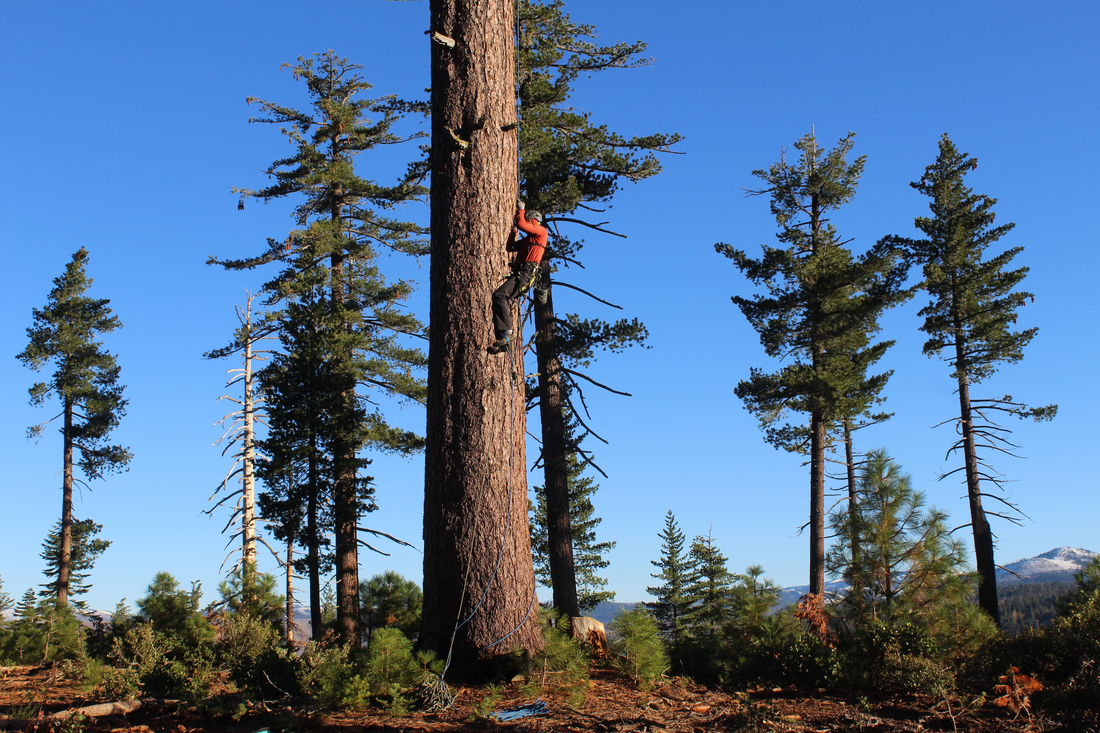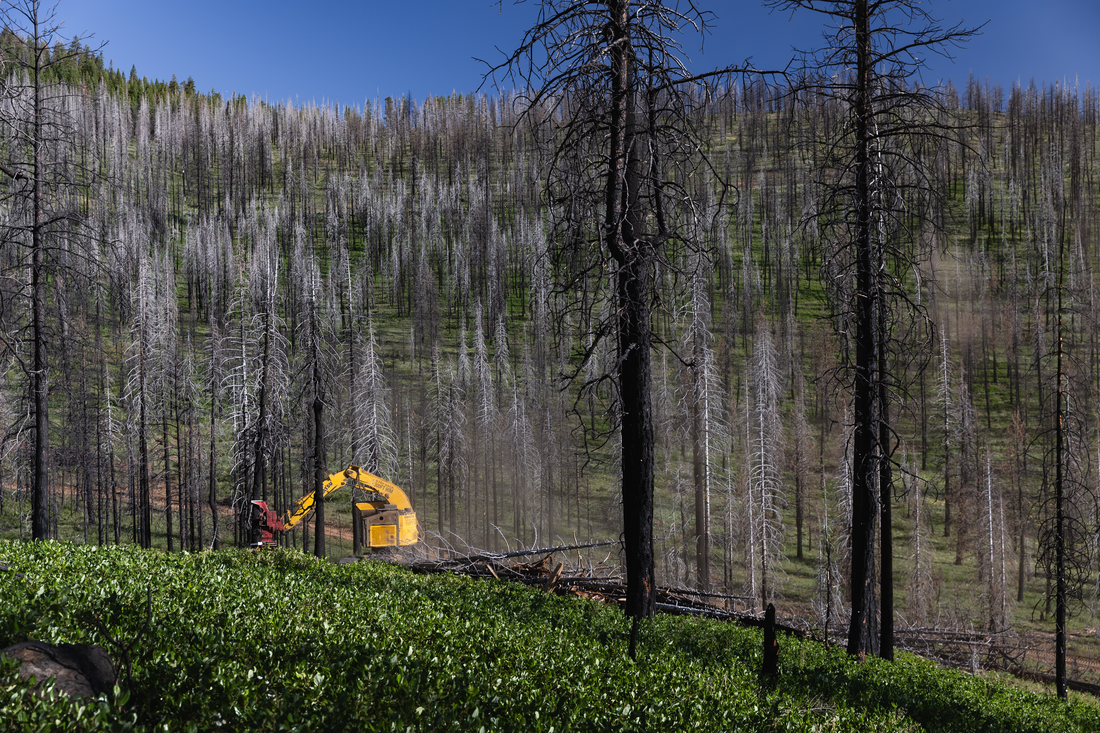This past June, I was near Placerville, California on the Eldorado National Forest, where the Caldor Fire burned more than 220,000 acres in 2021. It’s only one of the many recent unprecedented wildfires in which we’ve witnessed very large areas burn at such high severity that virtually every tree in the forest is killed. In just a few years, we’ve seen millions of acres deforested in this way – leaving forests incapable of regenerating on their own in our lifetimes.

Photo Credit: Luis Vidal / American Forests
The forests of the Sierra Nevada have adapted to live with low-severity fires, which have historically burned here. Before European colonization, the area rarely saw patches of high-severity burns larger than 10 acres. Now, we’re seeing sections of these larger fires in which thousands of acres are being destroyed.
Frequent and widespread low- to moderate-severity fires can benefit our forests by clearing excess brush and dead vegetation, and even enabling cones from fire-adapted conifers to open and release seed – clearing the way for healthy generations of trees. Historically, Indigenous people contributed to and reinforced this natural pattern of low-severity fires by routinely burning forests and grasslands, passing down knowledge learned about these processes learned through millennia. The relationship between fire, vegetation and people meant that forests not only survived fire, but thrived with it.
Over the last century, though, these bonds have been broken. Now, with climate change creating hotter, more intense fires, coupled with decades of actively putting out low-severity fire, we’ve short-circuited the natural resilience of these ecosystems, teeing up large transitions from forests to grass and shrub dominated landscapes – unless we take action.
I came to this part of California to look at one of the efforts to turn things around for our country’s forests. Here, American Forests is working with the U.S. Forest Service and our corporate partners like The Coca-Cola Foundation to reforest the area with the explicit purpose of creating a future forest with greater resilience to climate change and wildfire. What we’re doing in this forest is one part of an extraordinary $20 million partnership between American Forests and the Forest Service to help kickstart the restoration of more than 3.6 million acres of forests across the country: the largest climate-informed reforestation effort ever undertaken.

Photo Credit: Luis Vidal / American Forests
This partnership has been made possible through the REPLANT Act. Passed by Congress in November 2021, the REPLANT Act has directed more funding to our forests by expanding a dedicated trust fund for post-fire reforestation on national forests by as much as five times per year in perpetuity. As a result, American Forests’ REPLANT Initiative is partnering with the Forest Service to expand reforestation on National Forest System lands – in a way that is informed by the best available climate science.
In the year since we announced our REPLANT partnership with the Forest Service, we’ve been hard at work. American Forests has been meeting with each of the nine Forest Service regions across the country to help them plan what they need to grow their restoration programs over the next decade – whether it’s an expanded workforce, better application of science to guide recovery, or partners to leverage private funding and resources.
This year, we’re bringing other partners and donors into the fold, matching public and private funding to plant or regenerate nearly 2 million trees on national forests across the country. Some of these trees are part of the largest “assisted migration” trial ever conducted, a multi-agency, multi-region effort led by the Forest Service to identify how climate change is shifting the suitability of seed sources that will be needed to grow the millions of seedlings needed to regrow our forests.

Photo Credit: Andrew Studer
We’re also building up the enormous workforce of trained foresters and technicians needed to restore millions of acres of damaged forests. The California Cone Corps is a workforce development program with our partners at CAL FIRE and the Forest Service that is getting more young people involved in forest restoration through cone collection and nursery production of seedlings — an important part of building up new seed and seedling stock following fires. We’re also offering several multi-day “Cone Camps” at sites across California to provide free training and networking with regional seed experts and forest managers. Additionally, we’re engaging Tribal nations and rural communities with this and other programs to create opportunities for secure jobs and dedicated local wildfire recovery in some of the areas that wildfires affect the most.
In Oregon and Washington, Forest Service nurseries don’t have enough space to grow the seedlings needed to restore forests after a series of devastating wildfires. We’re using REPLANT Act funding for an innovative partnership with private nurseries to help fill in this gap.
Oregon is also the home of a unique effort in the Fremont-Winema National Forest that is bringing together everyone from the timber company Collins Pine to public and private landowners and corporate partners like Clif Bar & Company. Together, we’ve developed a comprehensive post-fire resilience strategy to address the recovery of both forests and the surrounding communities. This strategy has become a template for wildfire recovery efforts elsewhere in the country, including in Colorado, where we’re starting a similar effort using public-private partnerships to address the aftermath of 12 wildfires.

Photo Credit: Nick Grier
Lastly, we’re in the process of growing our own workforce. The next generation of skilled, talented, and dedicated staff are joining American Forests’ REPLANT Initiative to work in close partnership with our Forest Service colleagues in developing and carrying out similar efforts across the country.
All this work we’re doing with our partners goes so far beyond planting trees. Healthy forests support biodiversity and clean water for both wildlife and people. They can store carbon to mitigate climate change, too. The 1.2 billion trees we aim to plant in the next ten years will store the equivalent of emissions from 83.6 billion gallons of gasoline.
Healthy forests also keep communities healthy by providing jobs in industries from forest management to tourism. The REPLANT Act will add close to 49,000 new jobs in the next decade. And as forests start to recover, they will provide more places to enjoy the outdoors and make new memories with family and friends.
The REPLANT Act is not only making this work possible, but it’s also allowing American Forests to create unique partnerships that can address the overwhelming need to protect our forests both today and in the future. We can’t do it alone. But with our partners in federal agencies, other NGOs, Tribes, corporations, and local communities, we’re creating a movement that is truly restoring our forests, and which can ripple out to everyone whose lives are touched by them – which means all of us.
Brian Kittler is the chief program officer of American Forests’ Resilient Forests program. He is based in Cornelius, Oregon.